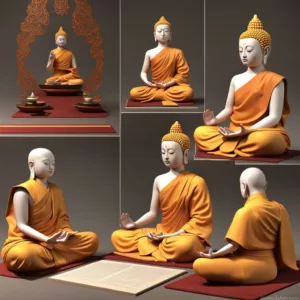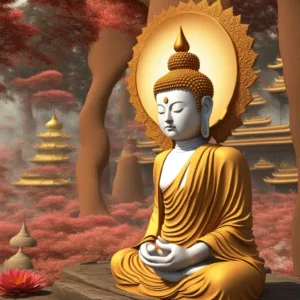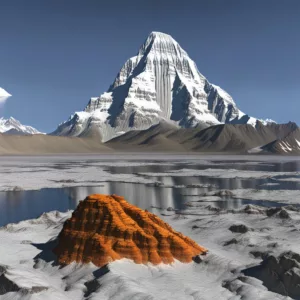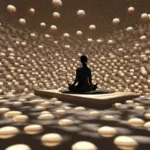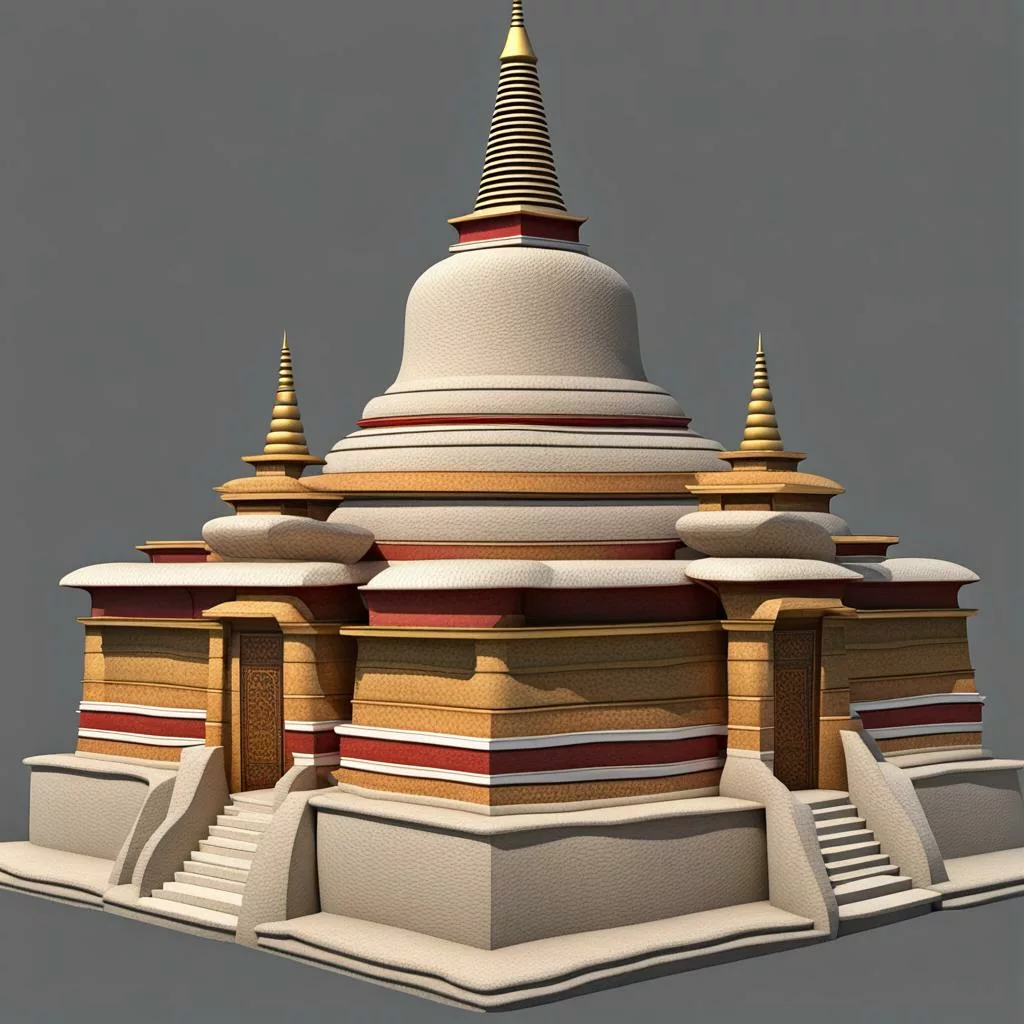
The stupa is a multi-layered structure serving as a highly symbolic monument to an enlightened being in Buddhist history. Each layer of the stupa represents a stage of the path.
Table of Contents
Stupa (Chorten), summary
| Central Entity | Description |
|---|---|
| Stupa (Chorten) | A dome-shaped religious monument in Buddhism. |
| Connected Entities | Description | Relationship to Stupa |
|---|---|---|
| Buddhism (Religion) | The religious tradition within which chorten are built. | Serves as a religious monument and symbol within Buddhism (Theravada, Mahayana, Vajrayana). |
| Buddha (Concept) | The enlightened teacher Siddhartha Gautama or other revered figures. | May enshrine relics of the Buddha or represent the Buddha’s presence. |
| Relics (Concept) | Physical remains or objects associated with enlightened beings. | May house relics of the Buddha or other revered figures. |
| Enlightenment (Goal) | The ultimate objective in Buddhism. | Represents the path to enlightenment through its form and function (e.g., symbolizing the Buddha’s awakened state). |
| Merit (Concept) | Positive karma accumulated through good deeds. | Can be a source of merit-making for those who build, visit, or maintain chortens. |
| Meditation (Practice) | A core Buddhist practice focusing on mental training. | Can serve as a focal point for meditation and contemplation. |
| Offerings (Practice) | Devotees presenting gifts to show respect and accumulate merit. | Place for offerings like flowers, incense, or prayers. |
| Pilgrimage (Practice) | A journey undertaken for religious reasons. | Destination for pilgrimage, with circumambulation (walking around) being a common practice. |
How to meditate like a yogi
and enter profound samadhi
Stupa: A Symbol of Enlightenment
The chorten, is a dome-shaped monument holding immense significance in Buddhism. These structures dot the landscapes of Asia, serving as powerful symbols of the Buddha, his teachings, and the path to enlightenment. This post delves into the history, symbolism, and architectural features of these sacred structures.
Stupa / Chorten Meaning
The word comes from the Sanskrit term “stūpa,” which translates to “heap” or “mound.” Over time, the meaning evolved to signify a commemorative structure or a reliquary. Similarly, “chorten” is a Tibetan term with the same meaning, literally translating to “offering container.” Essentially, chorten are monuments that enshrine relics of the Buddha, other revered figures, or sacred objects.
Symbolic Meanings of a Stupa’s parts
| Part of chorten | Description | Symbolic Meaning |
|---|---|---|
| Anda (dome) | Hemispherical base, the main body of the chorten. | Represents Mount Meru, the cosmic mountain in Buddhist cosmology, or the Buddha himself. |
| Harmika (fenced platform) | Square platform placed atop the anda. | Often houses relics or symbolizes the enlightened mind. |
| Yasti (vertical posts) | Upright pillars surrounding the harmika. | Symbolize the axis mundi (world axis) connecting the earthly and heavenly realms. |
| Medallion (decorative discs) | Relief carvings adorning the anda. | Depict stories from the Buddha’s life, Jataka tales, or auspicious symbols. |
| Harmika railing (enclosure) | Railing surrounding the harmika. | May symbolize the monastic community or the enclosure protecting the sacred relics within. |
| Spire (sometimes) | Tapering structure extending from the harmika. | Represents the path to enlightenment or the Buddha’s awakened mind reaching towards liberation. |
| Chattravali (umbrella) | Stone or metal structure resembling an umbrella atop the spire (not always present). | Represents protection, royalty, and the Buddha’s teachings sheltering beings from suffering. |
| Finial (topmost element) | Decorative element crowning the spire. | Often a lotus flower symbolizing purity, enlightenment, and spiritual growth arising from the mud of earthly existence. |
| Base | Square platform upon which the chorten rests. | Represents the earthly realm or the foundation for spiritual progress. |
| Circumambulation path | Path around the base of the chorten for walking meditation. | Represents the cyclical nature of life and the ongoing pursuit of liberation. |
Additional Notes:
- The specific symbolism of each element may vary slightly depending on the Buddhist tradition and regional interpretations.
- The overall form of the chorten, rising from a square base to a dome, symbolizes the Buddha’s journey from earthly existence to enlightenment.
- Offerings made at chorten, like flowers or incense, represent acts of merit-making and respect for the Buddha and his teachings.
Mahayana chorten
Within the Mahayana tradition of Buddhism, which emphasizes the path of the Bodhisattva (enlightened being who chooses to remain in the cycle of rebirth to help others), chorten may enshrine relics not only of the Buddha but also of other accomplished teachers and saints. They serve as a physical representation of the enlightened qualities these figures embodied.
Stupa Buddhism
chorten are deeply connected to the core principles of Buddhism. Their very form, a dome rising from a square base, symbolizes the Buddha’s journey from earthly existence to enlightenment. Circumambulating (walking around) a stupa is a common practice, representing the cyclical nature of life and the ongoing pursuit of liberation. Offerings of flowers, incense, or prayers made at stupas are seen as acts of merit-making, accumulating positive karma on the path to enlightenment.
Sanchi Stupa
One of the most famous examples of a chorten is the Sanchi chorten located in Madhya Pradesh, India. Dating back to the 3rd century BCE, this early chorten exemplifies the hemispherical dome structure with a square base and a harmika (fenced platform) atop the dome. The Sanchi chorten is renowned for its intricate sculptural reliefs depicting stories from the Buddha’s life and the Jataka tales (stories of the Buddha’s previous lives).
What is Stupa in History
The chorten evolved over time and across different Buddhist regions. Early stupas were simple earthen mounds, later transitioning to stone structures with more elaborate decorations. The function of stupas also expanded beyond housing relics to commemorate significant events in the Buddha’s life or serve as focal points for meditation and pilgrimage.
chorten Architecture
The key architectural elements of a stupa typically include:
- Anda: The hemispherical dome, representing the Buddha himself or the universe.
- Harmika: A fenced platform atop the dome, often housing relics.
- Yasti: Vertical posts symbolizing the axis mundi (world axis).
- Medallion: Decorative discs adorning the anda.
- Harmika railing: A railing surrounding the harmika, often adorned with intricate carvings.
- Spire (sometimes): A tapering structure atop the harmika, symbolizing the path to enlightenment.
Stupa Symbol:
The chorten, as a whole, is a powerful symbol in Buddhism. It represents the Buddha and his teachings, the concept of enlightenment, and the universe itself. Circumambulating a chorten is seen as a way to connect with these symbolic meanings and cultivate qualities like mindfulness and compassion.
Stupas in India:
India boasts a rich history of chorten, with numerous examples scattered across the country. Besides the Sanchi chorten, other notable Indian stupas include:
- Great chorten at Sanchi: An older structure surrounding the Sanchi chorten, dating back to the 2nd century BCE.
- Dhamek chorten at Sarnath: Marking the site where the Buddha delivered his first sermon after enlightenment.
- Mahabodhi chorten at Bodh Gaya: Marking the site where the Buddha attained enlightenment.
Most Famous Stupas – Table:
| Stupa Name | Location | Approximate Date | Description |
|---|---|---|---|
| Sanchi Stupa | Madhya Pradesh, India | 3rd century BCE | Early chorten with intricate carvings depicting the Buddha’s life. |
| Borobudur | Magelang Regency, Indonesia | 9th century CE | Mahayana chorten with multiple terraces adorned with Buddhist reliefs. |
| Shwedagon Pagoda | Yangon, Myanmar | Estimated 6th century CE | Gilded chorten considered the most sacred Buddhist site in Myanmar. |
| Boudhanath Stupa | Kathmandu, Nepal | Estimated 6th century CE | Largest chorten in Nepal with a distinctive all-seeing eyes design. |
Great Stupa of Dharmakaya – Largest Western Chorten
Nestled amidst the wooded hills of Colorado’s Red Feather Lakes lies a majestic monument. Unlike its ancient counterparts in Asia, this chorten isn’t shrouded in the mists of time. Built in 1988, it stands as a powerful testament to the enduring legacy of Buddhism in the West.
Constructed to honor Chögyam Trungpa Rinpoche, a renowned Tibetan meditation master and founder of the Shambhala Buddhist lineage, this 108-foot tall structure reflects both traditional chorten architecture and contemporary design influences. Crafted from concrete designed to withstand a thousand years, the structure embodies the enduring nature of the Buddha’s teachings. Visitors are drawn to its serene presence, a place for quiet contemplation and connection with the vastness of the Buddhist path. It serves as a vibrant symbol of peace and a beacon of hope, inspiring those seeking refuge and guidance on their spiritual journeys.
Secrets of Meditation for Anxiety
Like millions of people, you may have suffered from anxiety for years. Meditation, yoga, peaceful music – it never works. It takes too long, and it’s not stable. Why? Because peace is treated as a cause for freedom, but it’s not – it’s the result. The cause to free yourself from anxiety is completely different.
Click now to Overcome Anxiety for good.
Related Terms for Stupa (Chorten)
General Terms:
- Buddhist monument
- Buddhist architecture
- Reliquary stupa
- Symbol of enlightenment
- Buddhist pilgrimage site
Specific Terms:
- chorten vs pagoda
- Anatomy of a chorten
- Types of chorten (e.g., reliquary chorten, commemorative stupa)
- Famous stupchortenas (e.g., Borobudur, Boudhanath)
- chorten construction
Related Concepts:
- Buddhism (Theravada, Mahayana, Vajrayana)
- Relics (of the Buddha or saints)
- Nirvana (enlightenment)
- Merit-making in Buddhism
- Offerings (flowers, incense)
Cultural Aspects:
- chorten in Southeast Asian Buddhism
- Tibetan chorten
- chorten symbolism in art
- Pilgrimage to chorten
Additional Terms:
- Mandala (Buddhist sacred diagram)
- Thangka paintings (Tibetan Buddhist art)
- Chorten (another term for chorten)
- Buddhist meditation practices

May all beings be happy
May all beings be peaceful
May all beings be safe
May all beings awaken to the light of their true nature
May all beings be free


